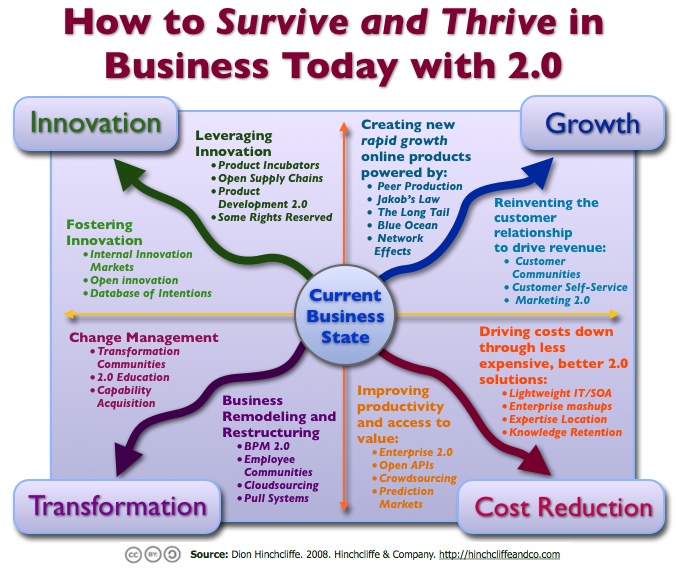Two of the big themes clearly evident at this week’s Web 2.0 Summit is 1) how to effect change successfully today and 2) how to deliver genuine, meaningful value in today’s marketplace. The current economic climate combined with this week’s seminal change in the current political administration has begun positioning organizations to think about how to not only survive the business environment and apparent recession today, but how to fundamentally transform what they’re doing for the better.
The era of get rich quick Internet startups has begun to give way to a quiet new pragmatism; rethinking what we’re doing in the world of business today — both online and traditional — to achieve qualitatively different and better outcomes, especially ones that aren’t exclusively financial. There are actually many opportunities, if we only know how to look for them, as Mary Meeker brilliantly explained here in San Francisco yesterday (video ).

Interest in achieving important secondary outcomes has become vital too. Reestablishing the trust we’ve lost recently in government and large institutions is certainly part of that, especially as the boundary and control of these are so much less certain in the 2.0 era. So is resolving many increasingly pressing issues around the resources we use to conduct business, civic affairs, and our personal lives. Our sources of human capital, who makes decisions for our organizations, where the best ideas are sourced, where our energy inputs will come from, and the models we use to build and service our customers/partners has increasingly changed. And it’s being changed by everything from open source software to peer production systems, which have remade entire industries (software and media being some of the most affected) with 2.0 ideas heading towards just about everything, even highly regulated industries.
However, this year’s collapse of many previously well-regarded (depending on your viewpoint) institutions has created a massive discontinuity in ongoing evolution of existing business models. One can make the argument that this disruption is the end state conclusion of 20th century business models, which had become less and less viable in the 2.0 era, where openness, transparency, and participation are the hallmarks. Combined with the business model astronautics that many traditional businesses engaged in along with the marketplace delivering a dramatic and painful wakeup call — specifically that recent directions in the traditional business world often just don’t work well anymore — and we have a mandate to dramatically transform what we do today.
These days many businesses large and small are actively planning how to make it through the current economic situation. Whether the current downtown lasts 4 months or 4 years, however, a new generation of business seems to be emerging. This had started to be clear a few years ago with the advent of all the things we like to call Web 2.0. But with the sudden and seismic changes in the business environment this year, we’ve now seen how Web 2.0 has become one of the most promising models for how we will design and build our products and services and self-organization our institutions drive our businesses into the future.
Exploring How To Survive and Thrive With Web 2.0
Over the next few weeks I’ll be posting a series of articles that deeply explore a strategy for using the power of Web 2.0 ideas to move businesses into the 21st century. These strategies will drive forward any organization to not only survive present economic circumstances but drive growth and innovation while transforming safely to what increasingly appears to be a generational change in the business landscape. In other words, what you’ve been doing in the past will often no longer apply in the future. The assumptions that we’ve learned in a previous generation of IT and business education and occupations are frequently mattering less and less to how we accomplish our work and live our lives.
Everything that we do today is now significantly impacted by 2.0 ideas. This applies to product development, marketing, customer service, operations, line of business, finance, communications, human resources, and just about everything in most organizations. How then do we start understanding the axes of opportunity and being applying to our organizations? My recent post on what CIOs and CTOs need to know about how to transform their organizations to Web 2.0 is a good start but it doesn’t go to the heart of the value proposition that become increasingly clear.
The scope of this subject is too broad to cover in a single post, though you can get a clear sense of the overall subject matter in the visual in the figure above. Consequently, I’ll begin exploring each quadrant of this visual over the next few weeks, looking at how to use 2.0 to dramatically create growth, transform the customer relationship to drive revenue, drive operational costs down, improve productivity, safely restructure our business models, effect change, and leverage/harnessing innovation. By strategically applying everything from Enterprise 2.0 and Product Development 2.0 to lightweight SOA (aka Web-Oriented Architecture) and peer production — to call out just a few of the relevant 2.0 concepts, organizations can reduce risk, create value, and map out potent avenues that lead towards a compelling set of new opportunities.
Survive and Thrive Uncon at Web 2.0 Summit in SF, Friday @ 1:15PM: I’ll be trying to use Twitter to organize a short, ad-hoc unconference session around these strategies tomorrow and I do hope you’ll come. Bring your own ideas and strategies on how to use the network to remake our businesses and I’ll roll it into this work. Anyone is welcome (even those not at the conference) and I will hold during lunch tomorrow at 1:15PM PST. Location and details to follow.
For further background, also be sure to read Umair Haque’s insightful Why Traditional Recession Tactics Are Doomed To Fail This Time from the Harvard Business School as well as my High Order Bit Keynote at Web 2.0 Expo Europe last month.
